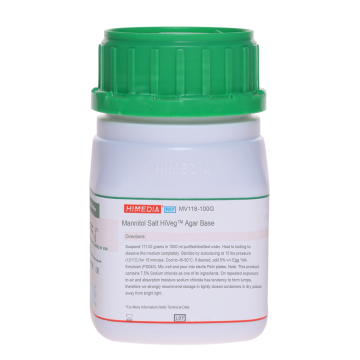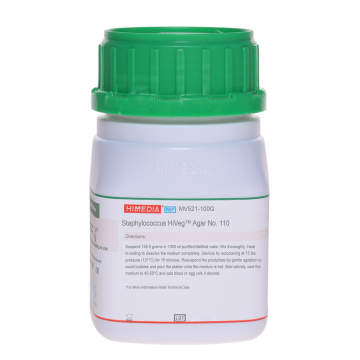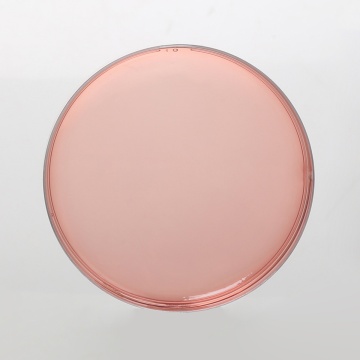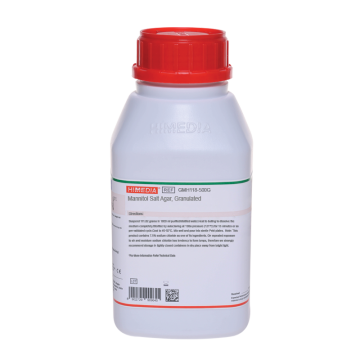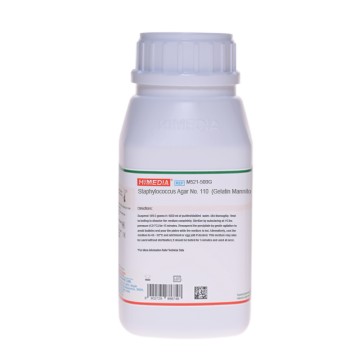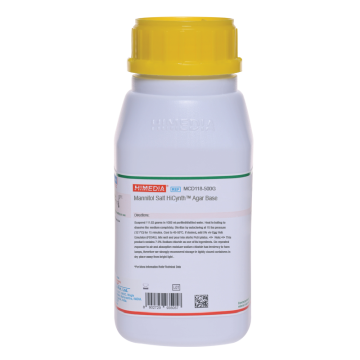 Your enquiry has been submitted
Your enquiry has been submitted
Mannitol Salt Agar Base
Intended Use
Recommended for the isolation of pathogenic Staphylococci from clinical and non-clinical samples.
Composition
| Ingredients | g/L |
|---|---|
| Proteose peptone | 10.000 |
| HM peptone B # | 1.000 |
| Sodium chloride | 75.000 |
| D-Mannitol | 10.000 |
| Phenol red | 0.025 |
| Agar | 15.000 |
Final pH (at 25°C): 7.4±0.2
**Formula adjusted, standardized to suit performance parameters # - Equivalent to Beef extract
Directions
Suspend 111.02 grams in 1000 ml purified / distilled water. Heat to boiling to dissolve the medium completely. Sterilize by autoclaving at 15 lbs pressure (121°C) for 15 minutes. Cool to 45-50°C. If desired, add 5% v/v Egg Yolk Emulsion (FD045). Mix well and pour into sterile Petri plates.
Note: This product contains 7.5% Sodium chloride as one of its ingredients. On repeated exposure to air and absorption moisture sodium chloride has tendency to form lumps, therefore we strongly recommend storage in tightly closed containers in dry place away from bright light.
Principle And Interpretation
Staphylococci are widespread in nature, although they are mainly found on the skin, skin glands and mucous membranes of mammals and birds. The coagulase-positive species i.e Staphylococcus aureus is well documented as a human opportunistic pathogen. The ability to clot plasma continues to be the most widely used and accepted criterion for the identification of pathogenic staphylococci associated with acute infections (1). Staphylococci have the unique ability of growing on a high salt containing media (2). Isolation of coagulase-positive staphylococci on Phenol Red Mannitol Agar supplemented with 7.5% NaCl was studied by Chapman (3). The resulting Mannitol Salt Agar Base is recommended for the isolation of coagulase-positive Staphylococci from cosmetics, milk, food and other specimens (1, 4,5,6,7). The additional property of lipase activity of Staphylococcus aureus can be detected by the addition of the Egg Yolk Emulsion (FD045). The lipase activity can be visualized as yellow opaque zones around the colonies (8).
HM peptone B and proteose peptone supply essential growth factors and trace nutrients to the growing bacteria. Sodium chloride serves as an inhibitory agent against bacteria other than staphylococci. Mannitol is the fermentable carbohydrate, fermentation of which leads to acid production, detected by phenol red indicator. S.aureus ferment mannitol and produce yellow coloured colonies surrounded by yellow zones. Coagulase-negative strains of S.aureus are usually mannitol non-fermenters and therefore produce pink to red colonies surrounded by red-purple zones. Presumptive coagulase-positive yellow colonies of S. aureus should be confirmed by performing the coagulase test [tube or slide] (1). Lipase activity of S.aureus can be detected by supplementing the medium with egg yolk emulsion.
A possible S.aureus must be confirmed by the coagulase test. Also the organism should be subcultured to a less inhibitory medium not containing excess salt to avoid the possible interference of salt with coagulase testing or other diagnostic tests (e.g. Nutrient Broth) (M002) (9). Few strains of S.aureus may exhibit delayed mannitol fermentation. Negative results should therefore be re-incubated for an additional 24 hours before being discarded (9).
Type of specimen
Clinical samples: pus, urine, etc.; Food and dairy samples.
Specimen Collection and Handling
For food and dairy samples, follow appropriate techniques for sample collection and processing as per guidelines (6,10,11). For clinical samples follow appropriate techniques for handling specimens as per established guidelines (12,13). After use, contaminated materials must be sterilized by autoclaving before discarding.
Warning and Precautions
In Vitro diagnostic use. For professional use only. Read the label before opening the container. Wear protective gloves/protective clothing/eye protection/face protection. Follow good microbiological lab practices while handling specimens and culture. Standard precautions as per established guidelines should be followed while handling clinical specimens. Safety guidelines may be referred in individual safety data sheets.
Limitations
- A possible S.aureus must be confirmed by the coagulase test.
- The organism should be subcultured to a less inhibitory medium not containing excess salt to avoid the possible interference of salt with coagulase testing or other diagnostic tests (e.g. Nutrient Broth) (M002) (9).
- Few strains of S.aureus may exhibit delayed mannitol fermentation. Negative results should therefore be re-incubated for an additional 24 hours before being discarded (9).
- Biochemical and serological tests must be performed for confirmation.
Performance and Evaluation
Performance of the medium is expected when used as per the direction on the label within the expiry period when stored at recommended temperature.
Quality Control
Appearance Light yellow to pink homogeneous free flowing powder
Gelling Firm,comparable with 1.5% Agar gel
Colour and Clarity of prepared medium Red coloured clear to slightly opalescent gel forms in Petri plates
Reaction Reaction of 11.1% w/v aqueous solution at 25°C. pH: 7.4±0.2
pH 7.20-7.60
Cultural Response
Cultural characteristics observed after an incubation at 35-37°C for 18-72 hours. Recovery rate is considered as 100% for bacteria growth on Soybean Casein Digest Agar.
| Organism | Inoculum (CFU) | Growth | Recovery | Colour of colony |
|---|---|---|---|---|
| Staphylococcus aureus subsp. aureus ATCC 6538 (00032*) | 50-100 | luxuriant | >=50% | yellow/white colonies surrounded by yellow zone |
| Escherichia coli ATCC 8739 (00012*) | >=104 | inhibited | 0% | |
| Staphylococcus aureus subsp. aureus ATCC 25923 (00034*) | 50-100 | luxuriant | >=50% | yellow/white colonies surrounded by yellow zone |
| Staphylococcus epidermidis ATCC 14990 (00132*) | 50-100 | fair-good | 30-40% | red |
| Proteus mirabilis ATCC 12453 | 50-100 | none-poor | 0-10% | yellow |
| Escherichia coli ATCC 25922 (00013*) | >=104 | Inhibited | 0% | |
| Escherichia coli NCTC 9002 | >=104 | Inhibited | 0% | |
| # Klebsiella aerogenes ATCC 13048 (00175*) | >=104 | Inhibited | 0% |
Key: (*) Corresponding WDCM numbers. (#) Formerly known as Enterobacter aerogenes
Storage and Shelf Life
Store between 10-30°C in a tightly closed container and the prepared medium at 20-30°C. Use before expiry date on the label. On opening, product should be properly stored dry, after tightly capping the bottle in order to prevent lump formation due to the hygroscopic nature of the product. Improper storage of the product may lead to lump formation. Store in dry ventilated area protected from extremes of temperature and sources of ignition. Seal the container tightly after use. Product performance is best if used within stated expiry period.
Disposal
User must ensure safe disposal by autoclaving and/or incineration of used or unusable preparations of this product. Follow established laboratory procedures in disposing of infectious materials and material that comes into contact with clinical sample must be decontaminated and disposed of in accordance with current laboratory techniques (12,13).
References
- Murray P. R., Baron J. H., Pfaller M. A., Jorgensen J. H. and Yolken R. H., (Ed.), 2003, Manual of Clinical Microbiology, 8th Ed., American Society for Microbiology, Washington, D.C.
- Koch P. K., 1942, Zentralbl. Bakteriol. Parasitenkd. Abt. I Orig. 149:122.
- Chapman G. H., 1945, J. Bacteriol., 50:201.
- Hitchins A. D., Tran T. and McCarron J. E., 1995, FDA Bacteriological Analytical Manual, 8th Ed., AOAC International, Gaithersburg, Md.
- Davis J. G., 1959, Milk testing, 2nd Ed., Dairy Industries Ltd, London.
- Salfinger Y., and Tortorello M.L., 2015, Compendium of Methods for the Microbiological Examination of Foods, 5th Ed., American Public Health Association, Washington, D.C.
- Silverton R. E. and Anderson M. J., 1961, Handbook of Medical Laboratory Formulae, Butterworths, London.
- Gunn B. A., Dunkelberg W. E. and Creitz J. R., 1972, Am. J. Clin. Pathol., 57:236.
- MacFaddin J. F., 1985, Media for Isolation-Cultivation-Identification-Maintenance of Medical Bacteria, Vol. 1, Williams and Wilkins, Baltimore
- American Public Health Association, Standard Methods for the Examination of Dairy Products, 1978, 14th Ed., Washington D.C.
- Wehr H. M. and Frank J. H., 2004, Standard Methods for the Microbiological Examination of Dairy Products, 17th Ed., APHA Inc., Washington, D.C.
- Isenberg, H.D. Clinical Microbiology Procedures Handbook 2nd Edition.
- Jorgensen, J.H., Pfaller, M.A., Carroll, K.C., Funke, G., Landry, M.L., Richter, S.S and Warnock., D.W. (2015) Manual of Clinical Microbiology, 11th Edition. Vol. 1.
| Product Name | Mannitol Salt Agar Base |
|---|---|
| SKU | M118 |
| Product Type | Regular |
| Physical Form | Powder |
| Origin | Animal |
| Packaging type | HDPE |
| References | 1.Murray P. R., Baron J. H., Pfaller M. A., Jorgensen J. H. and Yolken R. H., (Ed.), 2003, Manual of Clinical Microbiology,8th Ed., American Society for Microbiology, Washington, D.C. ,,2.Koch P. K., 1942, Zentralbl. Bakteriol. Parasitenkd. Abt. I Orig.149:122. 3.Chapman G. H., 1945, J. Bacteriol., 50:201. 4.Hitchins A. D., Tran T. and McCarron J. E., 1995, FDA Bacteriological Analytical Manual, 8th Ed., AOAC International,Gaithersburg, Md. 5.Davis J. G., 1959, Milk testing, 2nd Ed., Dairy Industries Ltd, London. 6.Salfinger Y., and Tortorello M.L. Fifth (Ed.), 2015, Compendium of Methods for the Microbiological Examination ofFoods, 5th Ed., American Public Health Association, Washington, D.C. 7.Silverton R. E. and Anderson M. J., 1961, Handbook of Medical Laboratory Formulae, Butterworths, London. 8.Gunn B. A., Dunkelberg W. E. and Creitz J. R., 1972, Am. J. Clin. Pathol., 57:236.9.MacFaddin J. F., 1985, Media for Isolation-Cultivation-Identification-Maintenance of Medical Bacteria, Vol. 1, Williamsand Wilkins, Baltimore10.Isenberg, H.D. Clinical Microbiology Procedures Handbook. 2nd Edition. 11. Jorgensen,J.H., Pfaller , M.A., Carroll, K.C., Funke, G., Landry, M.L., Richter, S.S and Warnock., D.W. (2015)Manual of Clinical Microbiology, 11th Edition. Vol. 1.1 2.American Public Health Association, Standard Methods for the Examination of Dairy Products, 1978, 14th Ed., WashingtonD.C. |
| Customized Product Available | No |




